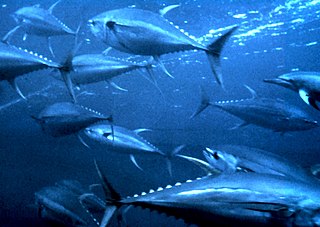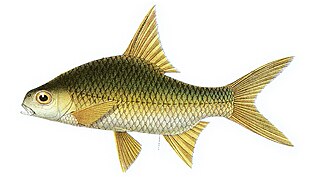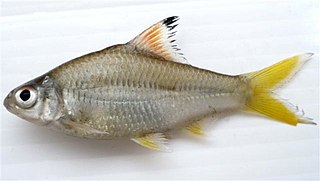
A tuna is a saltwater fish that belongs to the tribe Thunnini, a subgrouping of the Scombridae (mackerel) family. The Thunnini comprise 17 species across five genera, the sizes of which vary greatly, ranging from the bullet tuna up to the Atlantic bluefin tuna, which averages 2 m (6.6 ft) and is believed to live up to 50 years.

Mackerel is a common name applied to a number of different species of pelagic fish, mostly from the family Scombridae. They are found in both temperate and tropical seas, mostly living along the coast or offshore in the oceanic environment.

Herring are various species of forage fish, mostly belonging to the family of Clupeidae.

Sardine and pilchard are common names for various species of small, oily forage fish in the herring suborder Clupeoidei. The term 'sardine' was first used in English during the early 15th century; a somewhat dubious etymology says it comes from the Italian island of Sardinia, around which sardines were once supposedly abundant.

Carpet sharks are sharks classified in the order Orectolobiformes. Sometimes the common name "carpet shark" is used interchangeably with "wobbegong", which is the common name of sharks in the family Orectolobidae. Carpet sharks have five gill slits, two spineless dorsal fins, and a small mouth that does not extend past the eyes. Many species have barbels.

Sprat is the common name applied to a group of forage fish belonging to the genus Sprattus in the family Clupeidae. The term also is applied to a number of other small sprat-like forage fish. Like most forage fishes, sprats are highly active, small, oily fish. They travel in large schools with other fish and swim continuously throughout the day.

The onefin catshark is a species of shark belonging to the family Pentanchidae, the deepwater catsharks. It is the only member of its genus, Pentanchus. It is known from two specimens collected from the Tablas Strait and Mindanao Sea off the Philippines in the Western Central Pacific. It is classified as harmless to humans and of least concern to the IUCN redlist.

The narrowmouthed catshark is a coloured catshark beloning to the family Atelomycteridae, found from central Chile around the Straits of Magellan, to Argentina between latitudes 23° S and 56° S, at depths down to about 180 m (600 ft) in the Atlantic Ocean and about 360 m (1,200 ft) in the Pacific. It can grow to a length of up to 70 cm (28 in). The reproduction of this catshark is oviparous.

Thunnus is a genus of ocean-dwelling, ray-finned bony fish from the mackerel family, Scombridae. More specifically, Thunnus is one of five genera which make up the tribe Thunnini – a tribe that is collectively known as the tunas. Also called the true tunas or real tunas, Thunnus consists of eight species of tuna, divided into two subgenera.

Pusa is a genus of the earless seals, within the family Phocidae. The three species of this genus were split from the genus Phoca, and some sources still give Phoca as an acceptable synonym for Pusa.

Eels are ray-finned fish belonging to the order Anguilliformes, which consists of eight suborders, 20 families, 164 genera, and about 1000 species. Eels undergo considerable development from the early larval stage to the eventual adult stage and are usually predators.

An anchovy is a small, common forage fish of the family Engraulidae. Most species are found in marine waters, but several will enter brackish water, and some in South America are restricted to fresh water.

Genyomyrus is a monospecific genus of freshwater fish belonging to the family Mormyridae, the elephantfishes. The only species in the genus is Genyomyrus donnyi which is endemic to the Congo River. It reaches a length of about 45 cm (1.5 ft).
Folifer is a monospecific genus of brackish and freshwater ray-finned fish belonging to the family Cyprinidae, the carps, minnows and related fishes. The only species in the genus is Folifer brevifilis, a fish with a wide distribution in Southeast Asia and southern China, including Hainan. It is found in the middle and lower parts of flowing rivers where there is clear and open water, it avoids still water. The diet f this fish includes molluscs, crustaceans, insect larvae, algae and organic debris. This species attains sexual maturity after tw years and spawns over stont riverbeds in areas of clear and open water, This species has a maximum total length of 40.5 cm (15.9 in), although a standard length of 19.2 cm (7.6 in) is more typical. F. brevifilis is valued as a food fish but is not taken in large numbers. It may be a migratory species which may be impacted by dams and river diversions.

Kalimantania is a monospecific genus of freshwater ray-finned fish belonging to the family Cyprinidae, the family which includes the carps, barbs, minnows and related fishes. The only species in the genus is Kalimantania lawak, a fish found only in Indonesia where it is known from the Kapuas system in Kalimantan and from Ciliwung, Bogowonto and Brantas river systems in Java.
The Mexican rivulus is a species of killifish from the family Rivulidae which is endemic to Mexico where it is found in the Papaloapan and Coatzacoalcos River basins. This annual killifish grows to a total length of 4 cm (1.6 in). It is the only known species in its genus, but its exact taxonomic position remains uncertain, as it has not been included in any phylogenetic study. This species was described by Robert Rush Miller and Carl Leavitt Hubbs as Rivulus robustus in 1974, it was reclassified in the monotypic genus Millerichthys in 1995, the generic name honouring Robert Rush Miller.

The shaggy frogfish, also known as the hispid frogfish, shaggy anglerfish or zebra anglerfish, is a marine ray-finned fish belonging to the family Antennariidae, the frogfishes. This fish is found in the Indo-Pacific.

Mystacoleucus argenteus is a species of freshwater ray-finned fish belonging to the family Cyprinidae, the family which includes the carps, barbs, minnows and related fishes. This fish is found in Thailand and Myanmar in the drainage system of the Salween River.
Eirmotus octozona is a species of freshwater ray-finned fish beloning to the family Cyprinidae, a diverse family which includes the carps, barbs, minnows and related fishes. This species is thought to be found in southern Peninsular Malaysia but its range is uncertain as it is only known from the aquarium trade. It was first formally described in 1959 by the American ichthyologist Leonard Peter Schultz with its type locality given as Bueng Boraphet in central Thailand. This is likely to be an error as there is no suitable habitat, peat swamp, for Eirmotus species at this location and it has not been recorded there since. Like other species in the genus Eirmotus, of which this is the [[type species,, this species is a small fish with a maximum published standard length of 3.6 cm (1.4 in).

The smooth handfish is a possibly extinct species of handfish in the genus Sympterichthys. It was likely endemic to waters off the coast of Tasmania, mainly the D’Entrecasteaux Channel. It was declared extinct by the IUCN Red List in 2020, marking the first entirely marine fish classified as such. However, in 2021 its status was changed to Data Deficient due to uncertainties over the exhaustiveness of the unsuccessful surveys to find this species. It is known only from its holotype collected by French explorers in 1802.

















